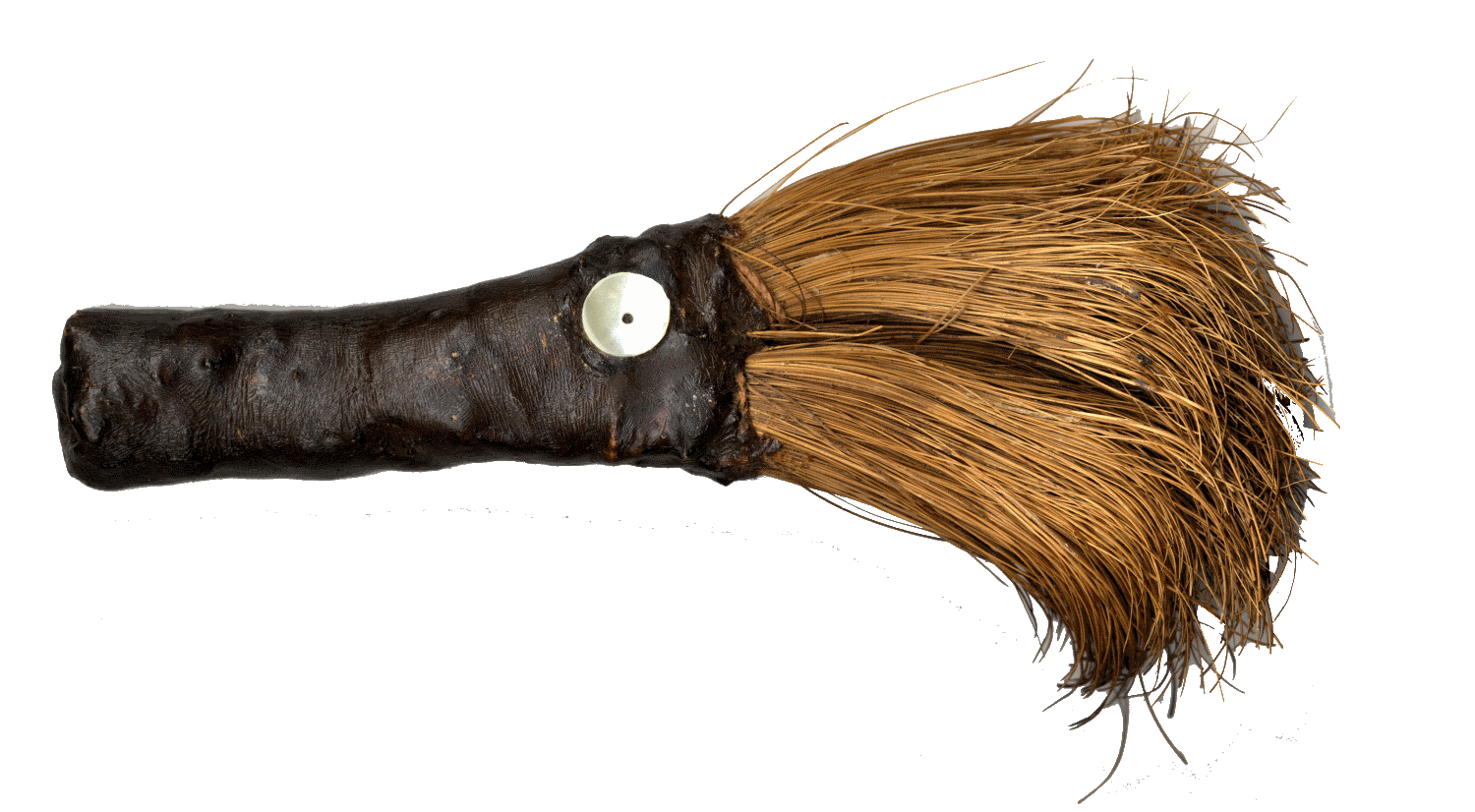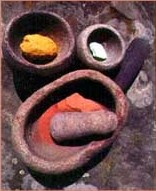Rock Art
- Binders or Binding Agents are liquids that are added to pigments to create paints. Water is an adequate binding agent that was sometimes used, but it is not as durable as other binders, and water-based paints will run if they dry out then become wet again. On the other hand, paints made with organic-based binders can darken over time, or get eaten by bugs. Plant oils worked the best for painting images on rocks, and Frank Latta (1999) writes that the oil from Wild Cucumber seeds (Marah macrocarpus), also called Chilicothe oil, was used by the Yokuts of the San Joaquin Valley, and probably by their Chumash neighbors in the mountains to the south. The seeds were chewed first to release the oils, which naturally mixed the oil with saliva. To this was then added juice squeezed from milkweed (Asclepias eriocarpa), which apparently contains an emulsifier called lecithin that makes the paint more resistant to water damage. These paints were readily absorbed by porous media, like rocks, and electrostatic forces associated with minerals in the rocks helped adere pigment to rock surfaces. However, these types of paints do not adhere well to smooth, water-tight surfaces, like skin, so grease from elk, deer or bear tallow provided the binder for body painting.
 Brushes for painting designs were made from fibers extracted from crushed soaproot bulbs (genus Chlorogalum). Crayons made from semi-hard lumps of paint pigment might be used to draw designs instead of painting them with a brush.
Brushes for painting designs were made from fibers extracted from crushed soaproot bulbs (genus Chlorogalum). Crayons made from semi-hard lumps of paint pigment might be used to draw designs instead of painting them with a brush.- Paint was made by combining pigment with a liquid binder. More binder made a liquid paint that was easily spread with a brush, less binder made a lump or cake of pigment that was easily carried, and which could also be used as a crayon to draw directly on a rock face.
- Petroglyphs are rock art images that are pounded or scratched on rock walls, or around bedrock mortars.
- Pictographs are rock art images that are painted or drawn on rock walls, and beneath overhangs and on the ceilings of rock shelters.
- Pigments are colored powders that are used to make paints. This is accomplished by adding a binding agent, which is a liquid that allows the pigment to be easily spread, and helps adhere it to the medium being painted. Most pigments are first finely crushed using a stone mortar and pestle, and then heated in a red hot stone bowl to drive off impurities, break various chemical bonds, and help reduce the pigment to a fine powder.

- Black pigments were sometimes made from charcoal, but more preferred was a crude form of graphite (pure carbon) that forms naturally in the cracks (joints) of decomposed granite bedrock buried beneath organic-rich soils. The graphite probably filtered down into the cracks when carbon from organic debris in the soil was slowly released over time, or rapidly released during a fire.
- Blue (false blue) pigments are not "true blues", but what is known as "optical blues", or "false blues", in which a gray pigment made from charcoal mixed with gypsum looks blue when painted next to orange or red. Because red is on one end of the color spectrum, and blue is on the other, our eyes perceive the white light as blue when it reflects off the gypsum particles. Some authors believe the gypsum was made by burning clam or mussel shells, but a more likely source are flakes of naturally-occuring gypsum found in soils developed on old lake (lacustrine) deposits on the west side of the San Joaquin Valley.
- Blue (true blue) pigments were typically made from azurite, which is a copper carbonate ore commonly found with green malachite (see below under green pigment) and is chemically similar to it. However, azurite when exposed to ultraviolet (UV) radiation from the sun eventually transforms into green malachite. Hence, some green pictographs may have originally been blue, but were altered by sun exposure. There is also mention here and there in some museum displays that ground glauconite was used as a pigment, which would have resulted in a blue-gray paint if the glauconite was used alone. However, glauconite in many places is found as blocks floating in a green matrix of serpentine, which makes it likely that chemical analyses of some green, serpentine-based pictograph paints would yield trace amounts of glauconite also.
- Green pigments were made from the green copper carbonate ore known as malachite that is sometimes found associated with gold deposits in the Alamo Mountain area of the San Emigdio Mountains. Malachite is also found at various sites in the Southern Serra Nevadas, such as the Miners Gulch area of Mountain Home Forest, where limestone deposits are intruded by granites. A source for a different shade of green pigment is "terre verte" or "green earth", which was made by grinding up and mixing the common mineral glaucophane, which is found in blueschist, with a more rare, mica-like mineral called celadonite. Both minerals are found on the west side of the San Andreas Fault associated with some serpentine deposits.
- Red and Brown pigments were made from hematite (Fe2O3), which is an iron oxide mineral that is called ochre (red earth) when it is found as a soil weathering product mixed with clay. It has the same basic chemical composition as rust. It differs from the yellow iron-oxide mineral limonite (yellow earth) in that no water is bound up in the hematite molecular structure, whereas limonite contains water/hydroxides.
- Vermillion pigments were made from cinnabar, which is an ore of mercury that is found in various locations in close proximity to the San Andreas Fault.
- White (shell) pigments were sometimes made from pulverized shells of small freshwater bivalves that are quite abundant today in the Kern River on the east side of the San Joaquin Valley, and in the now dried up lakes and marshes that characterized the east side in times past. These shells are actually mussels, though most people incorrectly call them clams, and they include the bottom-dwelling (benthic) Western Pearlshell (Margaritifera falcata) and the Western-ridged Mussel (Gonidea angulata), in addition to the floating (pelagic) mussel Anodonta californiensis. No doubt one of these made a better white pigment than the others, but we do not know which of the three worked best.
- White (diatomite) pigments were also made from soft diatomaceous rocks (Opal A diatomite) that are found here and there on the west side of the San Joaquin Valley. Opal A diatomite is different from porcellanite, or Opal CT diatomite, which is what we use today for kitty litter. Although porcellanite tends to be more common in outcrop, it is too hard to make a good pigment. Despite the fact that Opal A diatomite closely resembles chalk, it is actually made of the opaline silica shells (test) of microscopic plants called diatoms, whereas true chalk, which is very rare in the San Joaquin Valley, is made of the calcium carbonate (CaCO3) shells of micro-organisms called forams.
- Yellow pigments were made from the mineral limonite (FeO(OH)ĚnH2O), which is an iron oxide weathering product that is similar to the red ochre (rust/hematitie) used in red pigments, but has water/hydroxide incoporated into its molecular structure to give it a yellow color. Limonite is sometimes called "yellow ochre" or "yellow earth".
References
Campbell, Paul Douglas (2007), Earth Pigments and Paint of the California Indians - Meaning and Technology, Self Published, Los Angeles, California, 224 p.
Grant, Campbell (1993), Rock Paintings of the Chumash, published by the Santa Barbara Museum of Natural History and EZ nature Books, Santa Barbara, California (reprint of the original 1965 edition by the University of California Press), p. 84-87.
Latta, Frank (1999), Handbook of Yokuts Indians (50th Century Commemorative Issue), Coyote Press, Salinas, California (reprint of the original 1949 edition by Brewers Historical Press), p. 299-302 & 592-601.
|